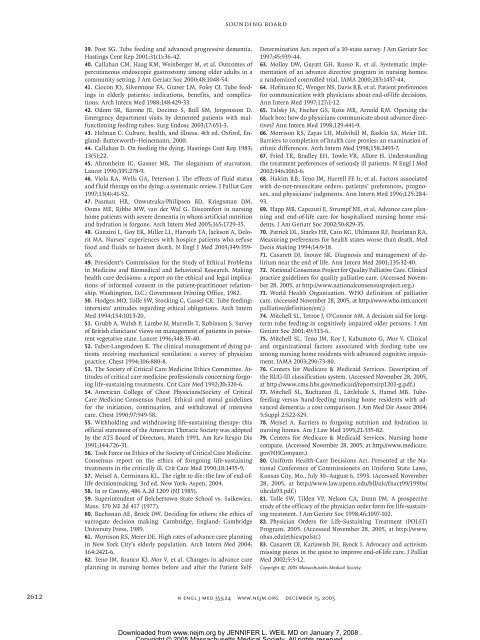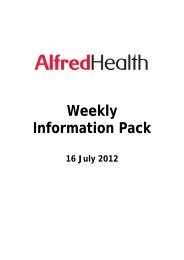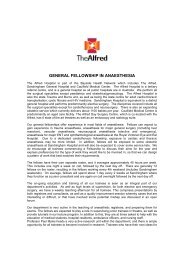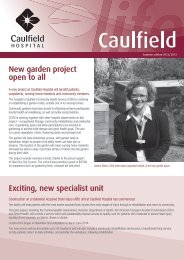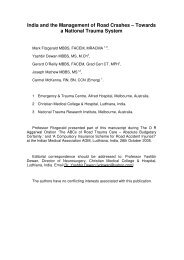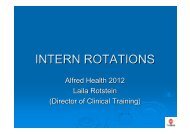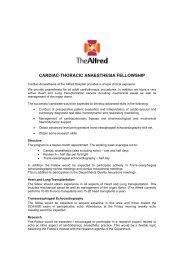Appropriate Use of Artificial Nutrition and Hydration — Fundamental ...
Appropriate Use of Artificial Nutrition and Hydration — Fundamental ...
Appropriate Use of Artificial Nutrition and Hydration — Fundamental ...
You also want an ePaper? Increase the reach of your titles
YUMPU automatically turns print PDFs into web optimized ePapers that Google loves.
sounding board<br />
39. Post SG. Tube feeding <strong>and</strong> advanced progressive dementia.<br />
Hastings Cent Rep 2001;31(1):36-42.<br />
40. Callahan CM, Haag KM, Weinberger M, et al. Outcomes <strong>of</strong><br />
percutaneous endoscopic gastrostomy among older adults in a<br />
community setting. J Am Geriatr Soc 2000;48:1048-54.<br />
41. Ciocon JO, Silverstone FA, Graver LM, Foley CJ. Tube feedings<br />
in elderly patients: indications, benefits, <strong>and</strong> complications.<br />
Arch Intern Med 1988;148:429-33.<br />
42. Odom SR, Barone JE, Docimo S, Bull SM, Jorgensson D.<br />
Emergency department visits by demented patients with malfunctioning<br />
feeding tubes. Surg Endosc 2003;17:651-3.<br />
43. Helman C. Culture, health, <strong>and</strong> illness. 4th ed. Oxford, Engl<strong>and</strong>:<br />
Butterworth–Heinemann, 2000.<br />
44. Callahan D. On feeding the dying. Hastings Cent Rep 1983;<br />
13(5):22.<br />
45. Ahronheim JC, Gasner MR. The sloganism <strong>of</strong> starvation.<br />
Lancet 1990;335:278-9.<br />
46. Viola RA, Wells GA, Peterson J. The effects <strong>of</strong> fluid status<br />
<strong>and</strong> fluid therapy on the dying: a systematic review. J Palliat Care<br />
1997;13(4):41-52.<br />
47. Pasman HR, Onwuteaka-Philipsen BD, Kriegsman DM,<br />
Ooms ME, Ribbe MW, van der Wal G. Discomfort in nursing<br />
home patients with severe dementia in whom artificial nutrition<br />
<strong>and</strong> hydration is forgone. Arch Intern Med 2005;165:1729-35.<br />
48. Ganzini L, Goy ER, Miller LL, Harvath TA, Jackson A, Delorit<br />
MA. Nurses’ experiences with hospice patients who refuse<br />
food <strong>and</strong> fluids to hasten death. N Engl J Med 2003;349:359-<br />
65.<br />
49. President’s Commission for the Study <strong>of</strong> Ethical Problems<br />
in Medicine <strong>and</strong> Biomedical <strong>and</strong> Behavioral Research. Making<br />
health care decisions: a report on the ethical <strong>and</strong> legal implications<br />
<strong>of</strong> informed consent in the patient-practitioner relationship.<br />
Washington, D.C.: Government Printing Office, 1982.<br />
50. Hodges MO, Tolle SW, Stocking C, Cassel CK. Tube feeding:<br />
internists’ attitudes regarding ethical obligations. Arch Intern<br />
Med 1994;154:1013-20.<br />
51. Grubb A, Walsh P, Lambe N, Murrells T, Robinson S. Survey<br />
<strong>of</strong> British clinicians’ views on management <strong>of</strong> patients in persistent<br />
vegetative state. Lancet 1996;348:35-40.<br />
52. Faber-Langendoen K. The clinical management <strong>of</strong> dying patients<br />
receiving mechanical ventilation: a survey <strong>of</strong> physician<br />
practice. Chest 1994;106:880-8.<br />
53. The Society <strong>of</strong> Critical Care Medicine Ethics Committee. Attitudes<br />
<strong>of</strong> critical care medicine pr<strong>of</strong>essionals concerning forgoing<br />
life-sustaining treatments. Crit Care Med 1992;20:320-6.<br />
54. American College <strong>of</strong> Chest Physicians/Society <strong>of</strong> Critical<br />
Care Medicine Consensus Panel. Ethical <strong>and</strong> moral guidelines<br />
for the initiation, continuation, <strong>and</strong> withdrawal <strong>of</strong> intensive<br />
care. Chest 1990;97:949-58.<br />
55. Withholding <strong>and</strong> withdrawing life-sustaining therapy: this<br />
<strong>of</strong>ficial statement <strong>of</strong> the American Thoracic Society was adopted<br />
by the ATS Board <strong>of</strong> Directors, March 1991. Am Rev Respir Dis<br />
1991;144:726-31.<br />
56. Task Force on Ethics <strong>of</strong> the Society <strong>of</strong> Critical Care Medicine.<br />
Consensus report on the ethics <strong>of</strong> foregoing life-sustaining<br />
treatments in the critically ill. Crit Care Med 1990;18:1435-9.<br />
57. Meisel A, Cerminara KL. The right to die: the law <strong>of</strong> end-<strong>of</strong>life<br />
decisionmaking. 3rd ed. New York: Aspen, 2004.<br />
58. In re Conroy, 486 A.2d 1209 (NJ 1985).<br />
59. Superintendent <strong>of</strong> Belchertown State School vs. Saikewicz.<br />
Mass. 370 NE 2d 417 (1977).<br />
60. Buchanan AE, Brock DW. Deciding for others: the ethics <strong>of</strong><br />
surrogate decision making. Cambridge, Engl<strong>and</strong>: Cambridge<br />
University Press, 1989.<br />
61. Morrison RS, Meier DE. High rates <strong>of</strong> advance care planning<br />
in New York City’s elderly population. Arch Intern Med 2004;<br />
164:2421-6.<br />
62. Teno JM, Branco KJ, Mor V, et al. Changes in advance care<br />
planning in nursing homes before <strong>and</strong> after the Patient Self-<br />
Determination Act: report <strong>of</strong> a 10-state survey. J Am Geriatr Soc<br />
1997;45:939-44.<br />
63. Molloy DW, Guyatt GH, Russo R, et al. Systematic implementation<br />
<strong>of</strong> an advance directive program in nursing homes:<br />
a r<strong>and</strong>omized controlled trial. JAMA 2000;283:1437-44.<br />
64. H<strong>of</strong>mann JC, Wenger NS, Davis RB, et al. Patient preferences<br />
for communication with physicians about end-<strong>of</strong>-life decisions.<br />
Ann Intern Med 1997;127:1-12.<br />
65. Tulsky JA, Fischer GS, Rose MR, Arnold RM. Opening the<br />
black box: how do physicians communicate about advance directives<br />
Ann Intern Med 1998;129:441-9.<br />
66. Morrison RS, Zayas LH, Mulvihill M, Baskin SA, Meier DE.<br />
Barriers to completion <strong>of</strong> health care proxies: an examination <strong>of</strong><br />
ethnic differences. Arch Intern Med 1998;158:2493-7.<br />
67. Fried TR, Bradley EH, Towle VR, Allore H. Underst<strong>and</strong>ing<br />
the treatment preferences <strong>of</strong> seriously ill patients. N Engl J Med<br />
2002;346:1061-6.<br />
68. Hakim RB, Teno JM, Harrell FE Jr, et al. Factors associated<br />
with do-not-resuscitate orders: patients’ preferences, prognoses,<br />
<strong>and</strong> physicians’ judgments. Ann Intern Med 1996;125:284-<br />
93.<br />
69. Happ MB, Capezuti E, Strumpf NE, et al. Advance care planning<br />
<strong>and</strong> end-<strong>of</strong>-life care for hospitalized nursing home residents.<br />
J Am Geriatr Soc 2002;50:829-35.<br />
70. Patrick DL, Starks HE, Cain KC, Uhlmann RF, Pearlman RA.<br />
Measuring preferences for health states worse than death. Med<br />
Decis Making 1994;14:9-18.<br />
71. Casarett DJ, Inouye SK. Diagnosis <strong>and</strong> management <strong>of</strong> delirium<br />
near the end <strong>of</strong> life. Ann Intern Med 2001;135:32-40.<br />
72. National Consensus Project for Quality Palliative Care. Clinical<br />
practice guidelines for quality palliative care. (Accessed November<br />
28, 2005, at http://www.nationalconsensusproject.org.)<br />
73. World Health Organization. WHO definition <strong>of</strong> palliative<br />
care. (Accessed November 28, 2005, at http://www.who.int/cancer/<br />
palliative/definition/en/.)<br />
74. Mitchell SL, Tetroe J, O’Connor AM. A decision aid for longterm<br />
tube feeding in cognitively impaired older persons. J Am<br />
Geriatr Soc 2001;49:313-6.<br />
75. Mitchell SL, Teno JM, Roy J, Kabumoto G, Mor V. Clinical<br />
<strong>and</strong> organizational factors associated with feeding tube use<br />
among nursing home residents with advanced cognitive impairment.<br />
JAMA 2003;290:73-80.<br />
76. Centers for Medicare & Medicaid Services. Description <strong>of</strong><br />
the RUG-III classification system. (Accessed November 28, 2005,<br />
at http://www.cms.hhs.gov/medicaid/reports/rp1201-g.pdf.)<br />
77. Mitchell SL, Buchanan JL, Littlehale S, Hamel MB. Tubefeeding<br />
versus h<strong>and</strong>-feeding nursing home residents with advanced<br />
dementia: a cost comparison. J Am Med Dir Assoc 2004;<br />
5:Suppl 2:S22-S29.<br />
78. Meisel A. Barriers to forgoing nutrition <strong>and</strong> hydration in<br />
nursing homes. Am J Law Med 1995;21:335-82.<br />
79. Centers for Medicare & Medicaid Services. Nursing home<br />
compare. (Accessed November 28, 2005, at http://www.medicare.<br />
gov/NHCompare.)<br />
80. Uniform Health-Care Decisions Act. Presented at the National<br />
Conference <strong>of</strong> Commissioners on Uniform State Laws,<br />
Kansas City, Mo., July 30–August 6, 1993. (Accessed November<br />
28, 2005, at http://www.law.upenn.edu/bll/ulc/fnact99/1990s/<br />
uhcda93.pdf.)<br />
81. Tolle SW, Tilden VP, Nelson CA, Dunn PM. A prospective<br />
study <strong>of</strong> the efficacy <strong>of</strong> the physician order form for life-sustaining<br />
treatment. J Am Geriatr Soc 1998;46:1097-102.<br />
82. Physician Orders for Life-Sustaining Treatment (POLST)<br />
Program, 2005. (Accessed November 28, 2005, at http://www.<br />
ohsu.edu/ethics/polst/.)<br />
83. Casarett DJ, Karlawish JH, Byock I. Advocacy <strong>and</strong> activism:<br />
missing pieces in the quest to improve end-<strong>of</strong>-life care. J Palliat<br />
Med 2002;5:3-12.<br />
Copyright © 2005 Massachusetts Medical Society.<br />
2612<br />
n engl j med 353;24 www.nejm.org december 15, 2005<br />
Downloaded from www.nejm.org by JENNIFER L. WEIL MD on January 7, 2008 .<br />
Copyright © 2005 Massachusetts Medical Society. All rights reserved.


